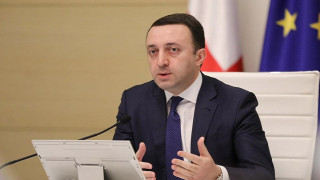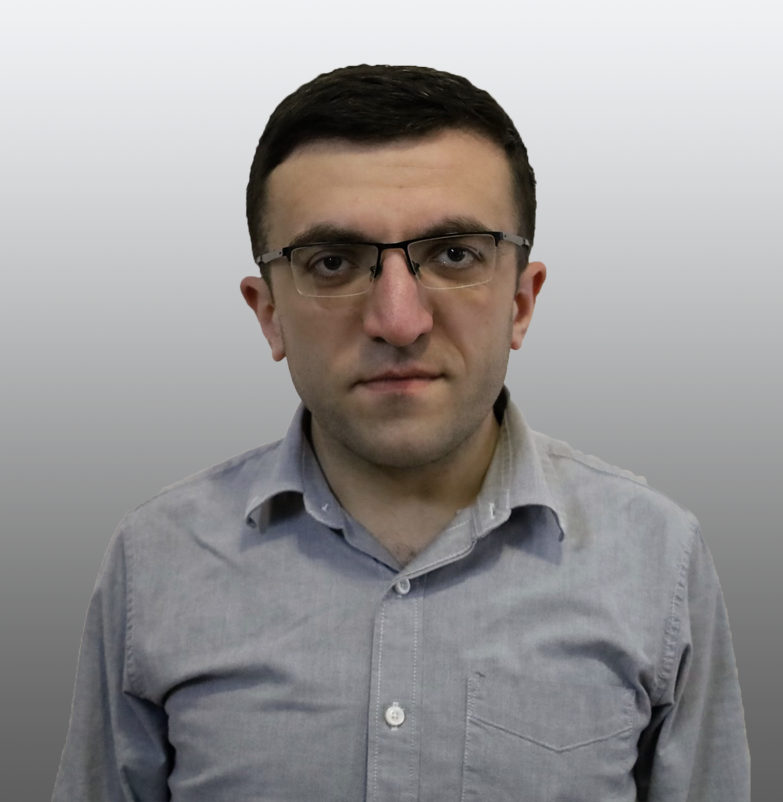Irakli Gharibashvili: “What the EU trades with Russia in four days equals our trade with Russia in one year. Our trade turnover with Russia is USD 1 billion at most.”
Verdict: FactCheck concludes that Irakli Gharibashvili’s statement is a MANIPULATION.
Resume:
In 2022, the EU-Russia trade turnover reached EUR 259 billion. Of this amount, EUR 55 billion was export and EUR 204 billion was import for the EU. At the same time, the Georgia-Russia total trade turnover was USD 2.5 billion – USD 652 million in exports and USD 1.835 billion in imports. On average, the EU’s daily trade turnover with Russia equals EUR 709.6 million which for four days would be EUR 2.838 billion – nearly USD 3.1 billion.
In 2022, the EU’s trade turnover with Russia for four days on average was indeed higher as compared to Georgia’s trade with Russia for the entire year. However, to make sure that the real context is not distorted, three important circumstances need to be taken into account: the size of the economy, the dependence ratio in the total trade turnover and the dynamic of changes in the trade turnover.
The EU’s economy is 675 times larger as compared to the Georgian economy and naturally it trades more with any country in the world. In 2022, Russia’s share in the EU’s total trade turnover was 3.1% whilst Georgia’s trade with Russia is 13.1%. In 2022, the EU increased its foreign trade turnover with Russia by 2.4% whereas Georgia’s growth amounted to 52.2%. The picture changed further in January-February 2023. Russia’s share in Georgia’s total trade turnover increased by 70% whilst trade with the EU decreased by 62% as compared to the same period of the previous year. As a result, Georgia’s trade dependence on Russia reached 16.1% whilst it dropped to 1.6% for the EU.
In his statement, the Prime Minister made an emphasis on the difference in absolute numbers – which happens because of the different sizes of the economies of Georgia and the EU – and disregarded the reduction of the EU’s reduced trade with Russia and Russia’s shrinking share in the EU’s trade turnover after Moscow’s invasion of Ukraine which is growing in the case of Georgia. As a result, it leaves with the impression that the EU continues to trade with Russia in a normal manner. The second part of the Prime Minister’s statement contains an important factual inaccuracy because Georgia’s trade turnover with Russia in 2022 was not USD 1 billion but 2.5 times more – USD 2.5 billion. Given this factual inaccuracy and the wrong interpretation of other accurate figures, FactCheck concludes that Irakli Gharibashvili’s statement is a MANIPULATION.
Analysis:
Prime Minister of Georgia, Irakli Gharibashvili, speaking about the restoration of direct flights between Russia and Georgia and the abolition of visas for Georgian nationals for short-term visits (90 days out of a 180-day period), said that the EU’s trade with Russia was larger as compared to Georgia’s. In particular, he stated (from 9:22): “Our trade with Russia is nearly USD 1 billion. This is a rough figure. Now, what is happening in case of Europe? I listened to one of the statements from an EU representative today and I would like to clarify to our public that what the EU trades with Russia in four days, our country trades for entire years. Do you understand? Therefore, when they in the EU disapproved of these flights (referring to direct flights between Russia and Georgia), when they disapproved of Georgia's trade and economic relations with Russia, they still trade with Russia today and what the EU trades in four days, we trade in a year.”
The bigger a country’s economy is, the more it produces and the more it exports (the size of export and the GDP are not directly proportional, since the N2 economy, China, is also the N1 exporter). At the same time, the bigger a country’s economy is, the bigger the consumption in that country which in turn increases the need for import. As of 2022, Georgia’s economy was USD 24.6 billion and the EU’s economy was 675 times larger at USD 16.6 trillion.
In 2022, Georgia’s foreign trade turnover amounted to USD 19.043 billion (USD 5.593 billion in exports and USD 13.450 billion in imports). At the same time, the EU’s foreign trade turnover reached EUR 8.329 trillion (EUR 4.229 trillion in export and EUR 4.100 trillion in imports). EUR 8.329 trillion is approximately USD 9.079 trillion which means that the EU’s trade turnover was almost 467 times larger as compared to Georgia’s trade turnover in 2022. Therefore, the fact that the EU trades more in monetary value with Russia cannot be evidence that it is more dependent on Russia in terms of trade. The ratio of dependence and an observation of the dynamic of changes is also needed:
1) In the case of Georgia, Russia’s share in the trade turnover in 2022 amounted to 13.1% (export 11.7%, import 13.6%, total turnover 13.1%). In the case of the EU, it was 3.1% (export 1.3%, import 5%, total turnover 3.1%).
2) In 2022, the EU’s export to Russia decreased by 38.2% as compared to 2021. Import from Russia increased by 24.4% (despite the total growth, there was a 34.7% drop in import in the fourth quarter) and the total trade turnover increased by 2.4%. In the same period, Georgia increased export by 6.8%, import by 79.4% and the total trade turnover swelled by 52.2%.
Graph 1: Changes of Georgia-Russia Trade Relations in 2022 as Compared to 2021
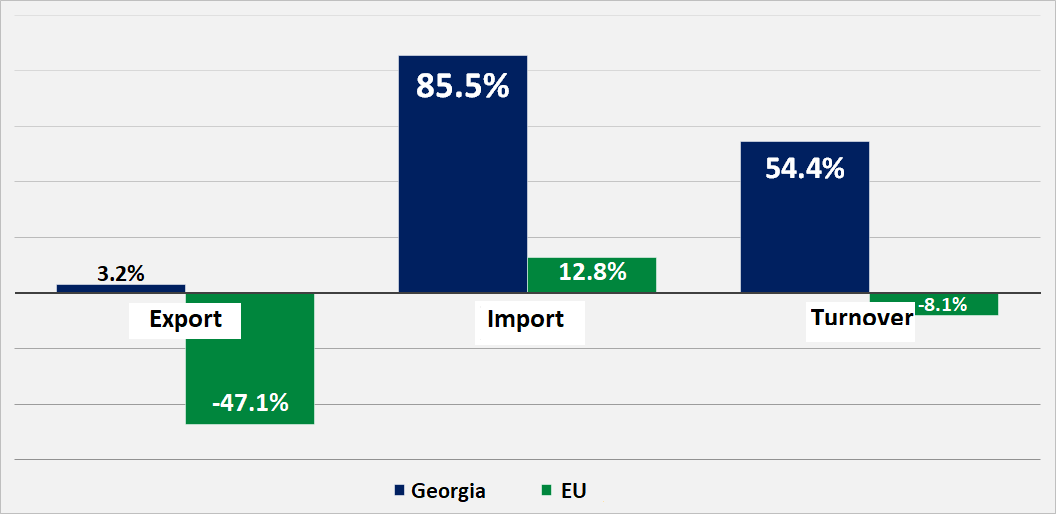
Source: National Statistics Office of Georgia and European Statistical Office (Eurostat)
For years, the EU has been one of the most important export destinations for Russia. The EU was mostly purchasing oil, petroleum products and natural gas from Russia as well as liquefied gas, coal and gold, albeit in smaller quantities.
Given the increased prices from energy carriers, the EU started to face more expensive Russian import as early as before the outbreak of the war. In January 2022, the EU paid EUR 20.6 billion for imports from Russia which is 105% more as compared to January 2021 and growth was 110% and 109% more, respectively, in February and March of 2022. From April 2022, the growth rate of Russia’s import value started to shrink, it was almost equal in the month of September as compared to the same period of the previous year and then started a real decrease from the month of October. In December, the value of the EU’s import from Russia was merely EUR 10.2 billion which is 44% less as compared to the same period of 2021.
Graph 2: Import from Russia to the EU (EUR Billion)
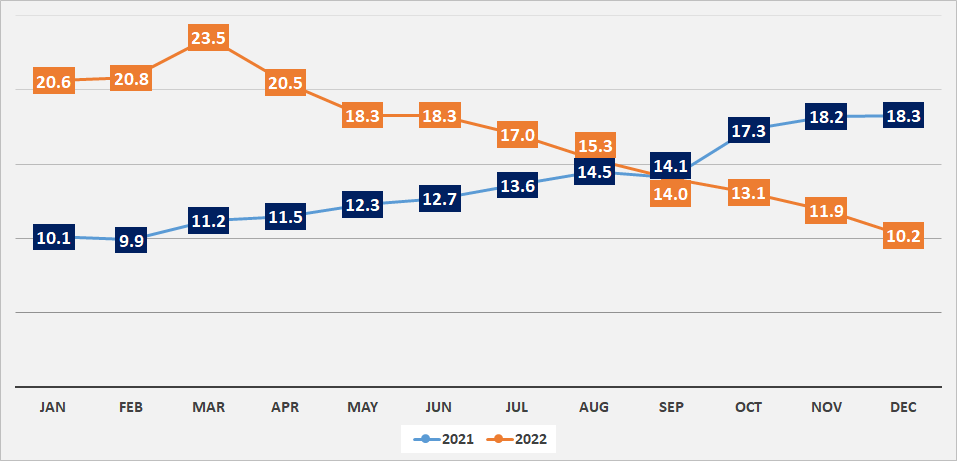
Source: European Statistical Office (Eurostat)
In regard to export from the EU to Russia, it was growing only in January and February before the outbreak of war. Since March to December 2022, the EU’s export to Russia was consistently less as compared to the same period of 2021.
The picture is absolutely different in the case of Georgia. In January 2022, Russia’s import increased by 54% as compared to January 2021 whereas the growth rate skyrocketed to 141% in December.
Graph 3: Import from Russia to Georgia

Source: National Statistics Office of Georgia
On top of the fact that Georgia increased its trade turnover with Russia more than the EU, it continued to maintain the growth rate throughout the year whilst the EU sought to reduce its trade dependency.
In his statement, the Prime Minister did not specify an exact timeframe. Since the war continues and sanctions imposed against Russia have been widened, it is possible to analyse 2023 as well. As of 15 May 2023, only two months of data are available from Eurostat which show that the EU purchased EUR 14 billion in products from Russia in January-February which is 66% less as compared to the same period of 2022. At the same time, the EU reduced export to Russia by 50% to EUR 7.2 billion in January-February and the EU-Russia total trade turnover dropped by 62% from EUR 55.8 billion to EUR 21.2 billion.
In the first two months of 2023, Georgia increased export to Russia by 38.1% to USD 128 million and import by 86% to USD 339 million. Consequently, the total trade turnover increased by 69.8% to USD 467 million.
For the EU, Russia’s share in export for January-February 2023 was 1.03%, it was 2.12% in import and 1.57% in the total trade turnover. For Georgia, Russia accounted for a 14% share in export, 17.1% in import and 16.1% in the total trade turnover. Based on the two months of data, Georgia’s ratio of trade dependence (in percentage) is ten times higher as compared to the EU’s dependence on Russia.
Graph 4: Trade Dependence on Russia (January-February 2023)
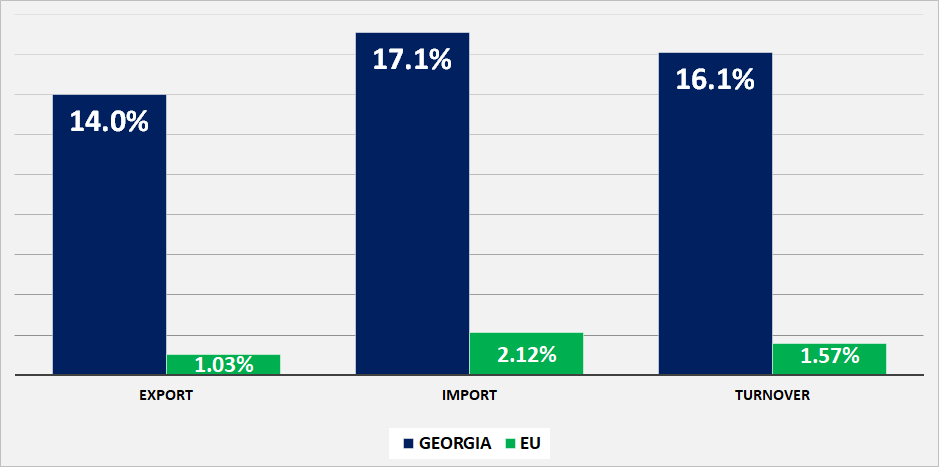
Source: National Statistics Office of Georgia and European Statistical Office (Eurostat)
Trade growth with any particular state, including Russia, which is waging a brutal war does not automatically mean a breach of sanctions. Despite the fact that this issue has been topical in the 15 months since the outbreak of Russia’s war in Ukraine, there has not been even a single case when there was confirmation of Georgia having breached the sanctions. FactCheck already published an article on this issue in February. The policy on the enforcement of sanctions has not changed in the following three months.
Georgia does not export military and dual-use products to Russia. It was also prohibited to export other sanctioned goods as well, including EU-made cars with a value above EUR 50,000. Ferroalloys, wine and mineral waters do not belong to the list of sanctioned products. Georgia also does not breach sanctions when buying Russian petroleum products and natural gas. Currently, there is no risk that Georgia will be sanctioned because of trade with Russia or because of the growth of the trade turnover with Russia.
The risk which the growth of the trade dependence with Russia entails actually comes from Russia itself. As result of a politically-motivated trade ban or in the case of an aggravated economic crisis as a result of failures at the frontlines, it is possible that Russia may restrict or ban export or import (or both) altogether. The higher the dependency when this risk materialises, the greater the problem.
The second part of the Prime Minister’s statement is simply false and contains an important factual inaccuracy. Georgia’s trade turnover with Russia in 2022 was not USD 1 billion but 2.5 times more – USD 2.5 billion (USD 652 million export and USD 1.835 billion import).
Despite the fact that the figure in the first part of the Prime Minister’s statement is accurate and the EU indeed trades more as compared to Georgia, it is still a manipulation because the EU is 10.3 times less dependent on Russia as compared to Georgia in terms of export. At the same time, as the EU decreased its trade turnover with Russia by 62%, Georgia increased it by 70%. In addition, no one has officially demanded that Georgia suspend trade with Russia. The second part of the Prime Minister’s statement is false since Georgia’s trade turnover with Russia in 2022 is USD 2.5 billion instead of USD 1 billion. Ultimately, FactCheck concludes that Irakli Gharibashvili’s statement is a MANIPULATION.

